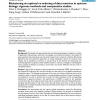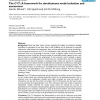BMCBI
2008
13 years 11 months ago
2008
Background: The use of novel algorithmic techniques is pivotal to many important problems in life science. For example the sequencing of the human genome [1] would not have been p...
BMCBI
2008
13 years 11 months ago
2008
Background: Despite increasing interest in applying Natural Language Processing (NLP) to biomedical text, whether this technology can facilitate tasks such as database curation re...
BMCBI
2008
13 years 11 months ago
2008
Background: The analysis of large-scale data sets via clustering techniques is utilized in a number of applications. Biclustering in particular has emerged as an important problem...
BMCBI
2008
13 years 11 months ago
2008
Background: Comparative genomics is the analysis and comparison of genomes from different species. This area of research is driven by the large number of sequenced genomes and hea...
BMCBI
2008
13 years 11 months ago
2008
Background: HLA haplotype analysis has been used in population genetics and in the investigation of disease-susceptibility locus, due to its high polymorphism. Several methods for...
BMCBI
2008
13 years 11 months ago
2008
BMCBI
2008
13 years 11 months ago
2008
Background: Subcellular localization information is one of the key features to protein function research. Locating to a specific subcellular compartment is essential for a protein...
BMCBI
2008
13 years 11 months ago
2008
Background: There has been recent concern regarding the inability of predictive modeling approaches to generalize to new data. Some of the problems can be attributed to improper m...
BMCBI
2008
13 years 11 months ago
2008
Background: Empirical binding models have previously been investigated for the energetics of protein complexation (G models) and for the influence of mutations on complexation (i....
BMCBI
2008
13 years 11 months ago
2008
Background: The construction of literature-based networks of gene-gene interactions is one of the most important applications of text mining in bioinformatics. Extracting potentia...



